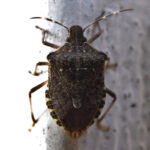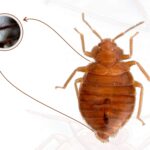Bed bugs are the most common type of bug in any home. For centuries, they have served as bloodsuckers. These bugs dwell under furniture and feed on human and animal blood. Bed bugs and fleas are similar in that they both suck blood, yet there are distinctions between these vampire bugs. We are aware that insects without wings are capable of leaping. Their leaps assist them in moving from one location to another. However, many people wonder if bedbugs can jump like other insects because they lack wings. Or can bedbugs jump from one location to another?
To address the previous questions, this article focuses on the facts and reasons about how can bedbugs jump and how to prevent them from entering your house.
Who are bed bugs?
Bed bugs are a kind of parasitic insects that feed exclusively on the blood of humans and animals as they sleep. Bed bugs are reddish-brown and wingless. Their size range from 1mm to 6mm and is equivalent to the size of an apple seed. They may survive months without feeding on blood. Bed bugs are distributed worldwide and can live in temperatures ranging from 46 to 113 degrees Fahrenheit. These bedbugs cannot jump or fly, yet they can crawl. Bedbugs are most active during the night time; however, in the daytime, they hide under furniture in their nests.
Do bedbugs jump?
The answer to the most commonly asked question; Can bed bugs jump is that; Bed bugs cannot jump like fleas or other bugs because they lack the long, slender, and powerful legs needed to help jump large distances. Instead, bed bugs crawl frequently. They are able to climb walls, roofs, and ceilings. When bed bugs take a ride on a human host body while feeding on their blood, they may travel from one area to the next in no time.
Why can bedbugs not fly?
Wing pads highlight where an insect’s wings normally form as it matures. Adult bed bugs have wing pads, although these are simply vestiges of wings. That is, their wings never fully grow, and they never learn to fly. Bed bugs are said to have formerly had wings but have evolved to no longer require them.
Another fascinating fact about bed bugs is that they have withered wings (really simply wing pads) that evolved from insects. As the bugs became less dependent on their wings to get food, the wings became obsolete, and they no longer had functioning wings. This adaption is comparable to that of certain other domestic pests, such as the cockroach.
Infestation of Bedbugs
Bed bug infestations are likely in or around sleeping areas since these pests are nocturnal. Bedbugs may infest flats, houses, hotels, rooms, transportation, railways, and hostels. These bugs prefer to hide and sleep during the day in places such as mattress seams, box spring seams, bed frames, dressing tables, gaps, under wallpaper, or any other object near a bed. Bed bugs have been shown to be capable of moving more than 100 feet in a single night, but they prefer to stay within 8 feet of where humans sleep in order to feed on their blood readily.
Bedbug bites during the day
Bedbug bites are common on the top of your body, especially around your face, neck, and arms. Because bedbugs are nocturnal bugs, they sleep in their nests during the day and are mostly active at night. Bedbugs, on the other hand, are opportunistic and will also attack during the daytime, especially if they have been starving for a long period. These bugs cannot survive without human blood; therefore, they must suck it at any cost, regardless of the time of day or night.
Bedbug transmission
Since bedbugs cannot jump or fly like other insects, the question arises; can bed bugs jump from one person to the next?
No, bedbugs cannot leap from any place to a person, but via traveling, they may readily spread to wherever people travel. So, how do bedbugs travel around? These smart bedbugs have the ability to cling to people. If a person spends his time in an infested region, even for a very short period of time, these bugs will cling to his stuff or clothes, seek a hiding place there, and remain there until they find a new location to shift to.
Since everyone uses public transportation, there is a high chance of bedbug shelters. People are most likely to use public transportation to travel and get to their destinations, and if there is a person with bed bugs, they may move away from him and land on any of the transport seats. These bugs may reproduce there for some time, and those new bugs may cling onto other passengers and accompany them to their separate homes. They may adhere to clothing, backpacks, baggage, and even your hair.
How Fast Do Bed Bugs Move?
Bed bugs cannot jump, but they can climb. They not only crawl up walls and furniture but also move quickly. On most surfaces, these troublesome bugs may creep three to four feet each minute. That may not appear quick, but in human terms, it is equivalent to a normal adult sprinting.
How can bedbugs climb?
Bed bugs have developed into skilled travelers as they cannot jump or fly. With the help of the six legs designed to crawl, an adult bed bug can cover up to four feet of distance in a minute. Each leg of the bedbug consists of a claw that may be essential to grab onto rough surfaces, climb, and hang onto a host while feeding or traveling. However, these insects lack suction pads, which makes it difficult for them to climb smoothly.
Bed bugs, unlike fleas, do not have excess protein resilin in their legs. To help bedbugs climb, Tibial pads are their legs’ anatomical features that allow them to grasp and climb on surfaces. When a bed bug crawls up a smoother surface, such as a wall or ceiling, it will utilize these tibial pads to help it stick to the surface. They will utilize their tarsal claws when they crawl on a rough, textured surface, such as a mattress or box spring.
How to Prevent Bed Bugs from Spreading
When you find you have bed bugs, there is just one thing you can do to keep the infestation contained in one location in your home.
- Keep your bedroom clean and free of debris.
- Avoid buying used furniture.
- Cover your mattress and box spring with protective zip covers.
- Vacuum your home on a daily basis.
- Inspect the sleeping place.
- Fix and fill any cracks.
- Deep clean mattress and clothes at high temperature.
How are bed bugs cured and prevented?
Bed bug bites are seldom dangerous to one’s health. Their bites can be treated by performing the following safety measures:
- Avoid scratching the affected area,
- Apply antiseptic creams or lotions.
- Take an antibiotic.
- Insecticide spraying is widely used to treat bed bug infestations.
- Regularly inspect for indicators of an infestation
Final Thoughts
Bed bugs are microscopic vampires that are invisible to the naked human eye. Because many different blood-sucking bugs are mistaken for bed bugs, and if people see a flea leaping, they mistake it for a bedbug. People wonder if bedbugs are able to jump since they have witnessed bugs jump in their homes. We have dedicated a whole article to answering the prevalent topic of; how bedbugs can jump. On the other hand, these tiny creatures are not like fleas or other blood-sucking insects. They have a distinct nature and features that set them apart in the world of insects.










